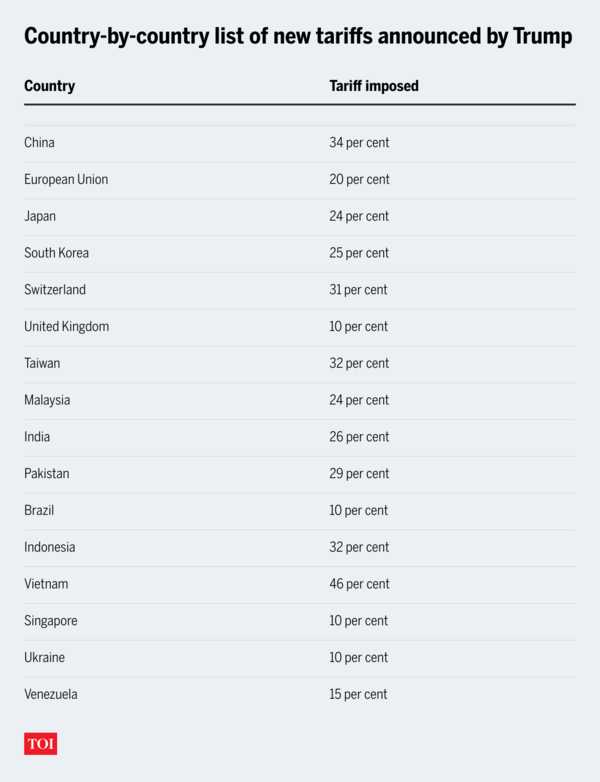TOI explainer: India likely to gain as Trump tariff shake-up hits Asia

In a sweeping move on April 2, 2025, US President Trump announced a comprehensive new tariff framework aimed at reducing America’s trade deficit and bolstering domestic manufacturing. Dubbed the “Reciprocal Tariff Policy,” the plan first introduces a 10% universal tariff on all imports, effective April 5 through April 8. From April 9, this will be replaced by a set of country-specific reciprocal tariffs, significantly altering the cost of accessing the US market for over 60 trading partners.
The policy outlines three categories of imports:
- Strategic goods like pharmaceuticals, semiconductors, copper, and energy products are fully exempt from any new tariffs.
- Critical industrial sectors such as steel, aluminium, and autos face a blanket 25% tariff.
- All remaining products fall under country-specific reciprocal tariffs, varying by trade imbalance and strategic priority.
Countries with large trade surpluses with the US, particularly in Asia, are among the most impacted. China tops the list, with certain goods now facing cumulative tariffs of up to 54%. Vietnam (46%), Bangladesh (37%), and Thailand (36%) follow closely.
It’s a mixed bag, not a setback: Commerce ministry
The commerce ministry is currently evaluating how the United States’ decision to impose 26% reciprocal tariffs on Indian imports will affect domestic industries, a senior government official said on Thursday.
“The ministry is analysing the impact of the announced tariffs,” the official said. They also noted that there is flexibility built into the US policy. “There is a provision that if a country would address the concerns of the US, the Trump administration can consider reducing the duties against that nation.”
“It is a mixed bag and not a setback for India,” the official added.
India’s tariff exposure: Lower than rivals, stronger opportunity
India’s position under the new regime is relatively advantageous. According to the Global Trade Research Initiative (GTRI) report, Indian goods face:
- 25% tariffs on steel, aluminium, and autos (same as most countries).
- Zero tariffs on pharmaceuticals, semiconductors, copper, and energy products.
- A country-specific reciprocal tariff of 27% on all other exports, applied from April 9.
While a 27% tariff is significant, it’s well below what many Asian competitors now face. This creates a window of opportunity for Indian exporters to expand their market share in the US—but only if domestic reforms enable them to meet global standards on cost, quality, and scale.
“The imposition of higher reciprocal tariffs by the United States on several Asian countries, including China, Vietnam, Taiwan, Thailand, and Bangladesh, presents an opportunity for India to strengthen its position in global trade and manufacturing,” the GTRI report notes.
Also read: Donald Trump announces reciprocal tariffs: Full list of countries impacted

.
Sector-specific opportunities for India
1. Textiles and garments: A ready pivot
India’s textile sector stands out as the clearest short-term winner. High US tariffs on garments from China (54%) and Bangladesh (37%) make Indian products significantly more competitive in price.
India already possesses a large and diverse textile manufacturing base, and this cost advantage could help attract new orders from American retailers looking to diversify away from higher-tariff suppliers. Additionally, global brands may shift production from Bangladesh and China to India to avoid tariff burdens, especially for high-volume, low-margin products.
2. Electronics and smartphones: PLI-led growth
The electronics sector is another major area where India can benefit, the GTRI report said. With Vietnam and Thailand now facing high US duties on electronics and telecom goods, India has an opening to position itself as a competitive alternative.
India’s Production-Linked Incentive (PLI) schemes, particularly for smartphones and components, have already spurred investment from global players like Apple and Samsung. This momentum, paired with tariff advantages, could further strengthen India’s role in the electronics supply chain—especially in assembly and component manufacturing.
3. Semiconductors: Lower-end entry point
Although India currently lacks the advanced semiconductor manufacturing capabilities of Taiwan or South Korea, the steep 32% tariff on Taiwanese goods could lead companies to diversify parts of the supply chain.
India has the potential to build capacity in lower-end segments like packaging, testing, and fabrication of legacy chips. With sustained infrastructure development and policy support, India could begin to participate meaningfully in the global chip ecosystem.
4. Machinery, toys, and auto components: Diversification ahead
US tariffs on Chinese and Thai exports also affect sectors such as machinery, automobile parts, and toys. India, if it plays its cards right, could position itself as an alternate source in these segments. However, the key challenges will be attracting foreign direct investment, scaling production, and maintaining quality standards.
India’s advantage is conditional, not automatic
Despite the tariff opening, the GTRI report stresses that benefits for India are not guaranteed. To capitalize on this moment, India must address long-standing structural issues that hinder manufacturing growth.
These include:
- Scaling up production capacity to meet large export orders.
- Enhancing domestic value addition so that goods are not just assembled but produced in India.
- Improving ease of doing business, particularly around labor laws, compliance, and taxation.
- Modernizing logistics and infrastructure to reduce costs and improve supply chain reliability.
Policy predictability and long-term investment in education and technical skills will also be essential to sustaining growth across manufacturing sectors.
“India needs deep reforms for enabling scale production, domestic value addition and improving competitiveness to benefit,” the GTRI report emphasizes.
(With inputs from agencies)





